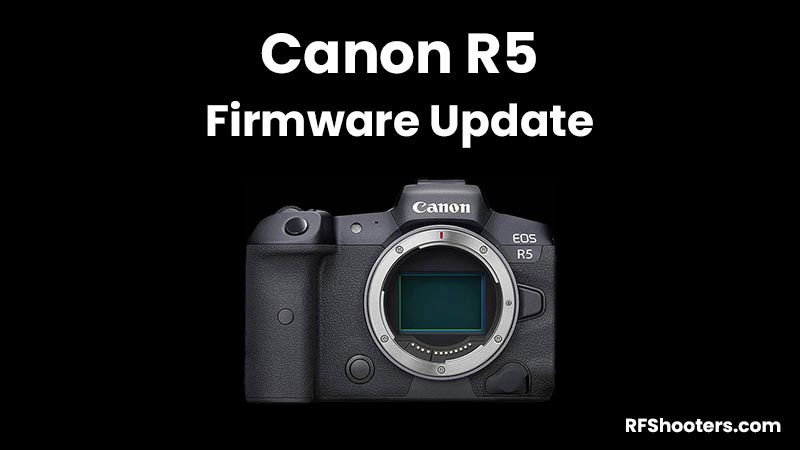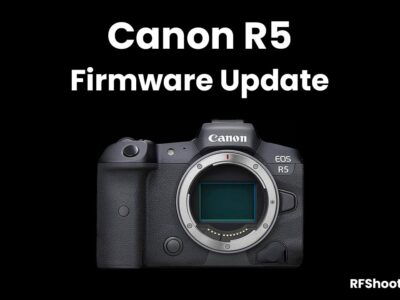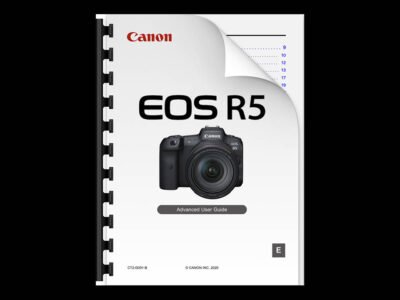The latest version of the firmware for the Canon EOS R5 is now version 2.2.0

Table of Contents[Hide][Show]
- What’s New in Firmware Version 2.2.0
- Firmware Download
- How to Install the Firmware
Previous Firmware Versions+−
- Changes in Version 2.1.0
- Changes in Version 2.0.0
- Changes in Version 1.9.0
- Changes in Version 1.8.1
- Changes in Version 1.7.0
- Changes in Version 1.6.0
- Changes in Version 1.5.2
- Changes in Version 1.5.1
- Changes in Version 1.5.0
- Changes in Version 1.4.0
- Changes in Version 1.3.1
- Changes in Version 1.2.0
- Changes in Version 1.1.1
- Changes in Version 1.1.0
- Canon R5 Guides & Resources
Canon R5 / R5 II Forum & Facebook Group
If you are looking for further help and advice on the Canon R5 / R5 Mark II or would simply like to share your photos and videos, then please head over to our friendly Forum. If you prefer Facebook then we also run the Canon R5 & R5II Shooters Group.
What’s New in Firmware Version 2.2.0
Firmware Version 2.2.0 incorporates the following enhancements and fixes:
1. Improves security features. A password must be set initially.
•Adds the ability to review the history of any changes made to the password, network information, or other settings.
*For more information, please refer to the ‘Setting a Password’ section in the Advanced User Guide on cam.start.canon.
2. Enables firmware updates to be performed when the camera is connected to the internet and if new firmware is made available on Canon servers.
3. Adds support for the Software Development Assistance Kit (EDSDK/CCAPI).
4. Adds a function that simultaneously protects images when they are rated.
5. Adds the ability to use up to 8 TB of CFexpress cards.
Note
・ Cards larger than 8 TB require low-level formatting by the camera.
・ Cards larger than 8 TB are treated as 8 TB cards.
・ Cards larger than 2 TB cannot be used for firmware updating.
6. Adds compatibility for Peripheral Coordinated Control with RF16-28mm F2.8 IS STM lens.
・With RF16-28mm F2.8 IS STM, Peripheral Coordinated Control only applies to still photo shooting.
7. Fixes an issue in which Err70 may occur during Bluetooth communication due to interference from other Bluetooth devices.
8. Fixes an issue in which Err70 may occur when repeatedly shooting in the “High-speed continuous shooting +” mode.
9. Fixes an issue in which HDMI output may momentarily stop when [Screen Off] is activated in the Power Saving settings.
If the camera’s firmware is already Version 2.2.0, it is not necessary to update the firmware.
Firmware Download
You can download the firmware from Canon’s Support Sites:
Make sure that you download the correct firmware for your computer (Windows or Mac).
How to Install the Firmware
Updating the firmware for the Canon R5 is a very straight forward and painless process.
When you download the firmware it will include a PDF guide on how to install the firmware, you can also download this guide here.
There are two methods described in this guide, I’d recommend using the card reader in your camera.
If you are using a Mac then clicking on the .dmg file will mount a drive in finder where you will then find the files.
Previous Firmware Versions
Improvements from previous firmware versions are always included in the latest firmware version. So even if you have missed a couple of firmware versions, you only ever need to install the latest version.
Changes in Version 2.1.0
Firmware Version 2.1.0 incorporates the following enhancements and fixes:
1. Enables functions to be used without limitation in conjunction with the new Battery Pack LP-E6P.
This makes it possible to shoot at the same continuous shooting speed as when using LP-E6NH.
In-camera charging of LP-E6P is also supported.
2. Adds [Protect Images] and [Rating] during FTP Transfer.
3. The following issues have been fixed.
3-1. Fixes an issue, in which when Wi-Fi is disconnected, Err 70 occurs.
3-2. Fixes an issue, in which when shooting subjects that are smaller in the frame, the card access indicator blinks and operations can no longer be performed.
3-3. Fixes an issue, in which when performing shooting in high-speed continuous shooting + mode with the [Highlight Tone Priority] option set to [ON], focus may not be achieved when certain ISO speed settings are used.
Changes in Version 2.0.0
Firmware Version 2.0.0 incorporates the following enhancements and fixes:
- Enables servo zooming to be remotely controlled from EOS Utility or Camera Connect when Power Zoom Adapter PZ-E2/PZ-E2B is attached to a compatible lens.
- Enables up to 2 TB to be used on CFexpress cards larger than 2 TB.
- Fixes an issue that may cause the camera, in rare instances, to experience a delayed restart after the camera has gone into Auto Power Off.
- Fixes an issue that, under specific circumstances, may prevent the image from being displayed in the viewfinder or on the screen causing the camera to stop operating, or Error Code 70 may be displayed.
- Fixes minor issues.
Changes in Version 1.9.0
Firmware Version 1.9.0 incorporates the following enhancements and fixes:
- Adds the ability to erase voice memos added to images and to add voice memos to protected images.
- Adds enhanced security when transferring images via FTPS transfer.
- Adds support for the Software Development Assistance Kit (EDSDK/CCAPI).
- Fixes an issue, in which, after touchscreen operation, in rare circumstances, the camera operations cannot be performed, and even if the camera is operated, [BUSY] appears on the screen.
- Fixes minor issues.
Changes in Version 1.8.1
Firmware Version 1.8.1 incorporates the following enhancements and fixes:
- Adds [IBIS High resolution shot] to the camera menu. By utilizing the in-body IS mechanism, it is now possible to record images with higher resolution.* *Use EOS Utility/Digital Photo Professional to check the images. EOS Utility/Digital Photo Professional will need to be upgraded.
- Adds [Save/load comm. settings on card] to the camera menu. Network settings can now be transferred between cameras of the same model.
- Adds the ability for images to be cropped and resized during transfer to the FTP server.
- Adds Protect Images During [FTP Transfer] to the camera menu. Images transferred via FTP can now be automatically protected. The user can determine if images have already been transferred via FTP.
- Fixes minor issues.
If the camera’s firmware is already Version 1.8.1, it is not necessary to update the firmware.
Changes in Version 1.7.0
Firmware Version 1.7.0 incorporates the following fixes:
- Fixes an issue that, in rare instances, may result in the camera not operating normally when capturing small subjects.
- Fixes minor issues.
Changes in Version 1.6.0
Firmware Version 1.6.0 incorporates the following enhancements and fixes:
- Adds [Auto Power Off Temp.: Standard/High] to the menu for movie recording. When [High] is selected, the camera will not automatically turn off when the temperature of the camera body and card become high, which may allow for longer movie recording than before, depending on the shooting conditions. Note that the temperature of the bottom surface of the camera may increase at this time.
- Adds the ability to convert multiple HEIF images into multiple JPEG images.
- Enhances the performance of “Movie Digital IS”. It stabilizes the image when taking selfies or walking shots using a wide-angle lens.
- Fixes minor issues.
Changes in Version 1.5.2
Firmware Version 1.5.2 incorporates the following improvements:
1. Optimizes AutoFocus accuracy when Extender RF1.4x or Extender RF2x is attached to the RF800mm F5.6 L IS USM and RF1200mm F8 L IS USM lenses.
2. Enhances the stability of Eye Detection.
3. Enhances AutoFocus tracking when shooting moving subjects.
Changes in Version 1.5.1
Firmware Version 1.5.1 incorporates the following fix:
1. Fixes an issue that in rare instances, the camera may become inoperable when shooting in the Servo AF setting while operating the
Changes in Version 1.5.0
Firmware Version 1.5.0 incorporates the following fixes and enhancements:
1. Improves head detection performance to support helmets or goggles in winter sports.
2. Adds [Vehicles] selection to [Subject to detect] selection in the [AF] tab to support the detection of automobiles and motorcycles in motorsports. Adds [Spot detection] when [Vehicles] is selected as the helmet of the driver or rider*.
*Detection may not be possible for ordinary passenger cars or bicycles, or for motorcyclists performing stunts or kicking up dirt and dust.
3. Improves detection performance for eye detection when:
-there are shadows on the face.
-hair is hanging over the eyes.
4. Adds support for torso detection of a person. If the eyes, face or head are hidden or cannot be detected, a person’s torso will be detected and tracked continuously.
5. Adds the ability to import manual white balance (MWB) data from the Quick Control screen when capturing still images.
6. Eliminates the center press operation of the multi-controller to prevent accidentally transferring images during FTP transfer.
7. Adds the ability, when using EOS Utility for remote shooting with two cards inserted, to set the recording method and to select which card to be recorded to.
8. Adds [Suppress lower frame rate] to [Smooth] in [Disp. performance], enabling the shooting screen to be displayed with less drop frame rate even in dark locations.
9. Adds support for the RF 5.2mm F2.8 L Dual Fisheye lens.
10. Changes the default value of [FTP server] → [Passive mode] to [Enable].
11. Improves operation stability during FTP transfer.
12. Optimizes controls of In-Body Image Stabilization (IBIS) when using specific EF lenses not equipped with the image stabilization function.
13. Fixes an issue, in which noise occurs along the edges of bright subjects when using Canon Log for movie recording.
Changes in Version 1.4.0
Firmware Version 1.4.0 incorporates the following fixes and enhancements:
1. Adds support for outputting 8K/30p/10-bit video signals for ProRes RAW recording to ATOMOS’s Ninja V+ recorder* via HDMI. * If you have any questions about ATOMOS products, please contact ATOMOS directly. * Please note that the recorder may become hot.
2. Adds support for movie recording when the camera is connected to the CN-E18-80mm T4.4 L IS KAS S or CN-E70-200mm T4.4 L IS KAS S EF cinema lenses. * Still photography shooting is possible however performance is not guaranteed. * Movie shooting in vertical position is possible however performance is not guaranteed. * External power supply is required for AF operation during servo zoom operation. When there is no external power supply, AF operation is activated only when the servo zoom is not in use.
3. Adds simultaneous movie recording capability on card 1 and card 2, however RAW movies and RAW(Light) movies cannot be recorded simultaneously on card 1 and card 2.
4. Adds support for the VPG 400 (Video Performance Guarantee Profile), a standard based on the CFexpress 2.0 specification.
5. Improves operation stability when using the RF400mm F2.8 L IS USM and RF600mm F4 L IS USM.
6. Fixes an issue in which, during HDMI connection, if the camera’s screen turns off, a zebra pattern is displayed via the HDMI output.
7. Fixes an issue in which sufficient image stabilization effects may not be attained immediately after the start of shooting.
Changes in Version 1.3.1
Firmware Version 1.3.1 incorporates the following fixes and enhancements:
- Adds [Canon Log 3] to [Canon Log settings]. You can select [Canon Log] or [Canon Log 3] from [Canon Log settings] in the Shooting tab of the menu. – Support for RAW movies shot with Canon Log3 and RAW (Light) will be available in Cinema RAW Development and in Digital Photo Professional version in a future update. – Digital Photo Professional will also support the processing of RAW movies shot in Canon Log3 settings and the application of Viewing LUT in future update.
- Adds [RAW (Light)] to the movie recording size and [IPB (Light)] to 8K/4K to enable lower bit rate shooting. These settings can also be selected when RAW+MP4 is set.
- Adds a high frame rate of 119.9 fps/100.0 fps to the Full HD movie recording size.
- Adds [Electronic full-time MF] to the AF tab of the menu. When a lens is attached, manual focus adjustment is always possible with both One-shot AF and Servo AF.
- Adds [6: Monitor Off] to [Shooting info. disp.: Screen info. settings] in the Shooting tab of the menu. This update makes it possible for the camera’s monitor to be turned off at all times during shooting.
- The transfer time (estimated value) now displays on the camera monitor during FTP transfer.
- Adds the ability, when transferring images via FTP, to select protected images that failed to be transferred and protected images that have not yet been transferred and transfer them all at once.
- Adds [Save/load cam settings on card] to the Function settings tab of the menu. This allows you to save the camera settings to a card, or load a saved file and restore the camera to the settings you saved to a card.
- Fixes a phenomenon, in which, in rare instances, the camera does not function normally when using certain CFexpress cards.
- Fixes a phenomenon, in which in rare instances, the camera cannot function normally when the drive mode is set to “High-speed continuous shooting” to shoot still images continuously.
- Fixes a phenomenon in which the power may become suspended when the camera is powered via USB for an extended period of time.
- Fixes a phenomenon, in which when shooting with Canon Log 3, if the [View Assist.] setting is set to [On], the image in the viewfinder and on the LCD screen is displayed brighter than it should be.
Note: Items 1 through 12 apply to Version 1.3.0, whereas Item 13 applies to Version 1.3.1.
Changes in Version 1.2.0
- When using high-speed or low-speed continuous shooting modes, in Drive Mode with [High Speed Display: OFF], the visibility of the subject within the frame has been improved when shooting moving objects.* *During continuous shooting black frames will be inserted between frames in the viewfinder and live view. This will improve the visibility of moving subjects in live view and in the viewfinder.
- Adds the [Auto] setting to the [Viewfinder brightness] menu that will brighten and dim based on ambient light conditions.
- Enables 2nd curtain shooting sync during radio transmission wireless flash shooting when the Speedlite EL-1 flash is attached to the camera.
- Enables manual flash output (excluding high-speed sync and optical transmission wireless flash shooting) to be selected and set up to 1/8192 from the camera menu screen when the Speedlite EL-1 flash is attached to the camera.
- Improves compatibility of HEIF images recorded in the camera with MIAF (Multi-Image Application Format) standards.
- Adds support for AF and release during zoom operations for some RF and EF lenses.
Changes in Version 1.1.1
- When the RF100-500mm F4.5-7.1 L IS USM lens is attached, an image stabilization effect of approximately six stops* is achieved through collaborative control with the in-lens image stabilization. *Focal length 500mm, Based on CIPA(Camera & Imaging Products Association) standards.
- Fixes a phenomenon in which the IS capabilities may be degraded when performing continuous shooting in cases where the RF100-500mm F4.5-7.1 L IS USM lens is attached to the EOS R5 running firmware version 1.1.0.
Changes in Version 1.1.0
- Useful messaging is now displayed when [HDMI display: Camera+External monitor] and [Overheat control: on] settings are enabled.
- When using certain RF lenses for movie shooting, the in-lens image stabilization mechanism has been improved.
- Fixes a phenomenon in which the “Slow Synchro” setting screen is not accurately displayed, when the language is set to English.
- Fixes a typo displayed on the communication setting screen, when the language is set to Korean.
- Connectivity during FTP transmission has been improved.
- Fixes a phenomenon, in which the card access time may take longer, when using certain CFexpress cards.
- Temperature detection and shooting time control in video shooting have been improved. In addition, the total shooting time when the short-time recording and power-on/off are performed repeatedly at room temperature is improved.
- The phenomenon in which the movie recording time available is not correctly displayed when the Date/Time/Zone is not set has been corrected.
Canon R5 Guides & Resources
Canon R5 / R5 II Forum & Facebook Group
If you are looking for further help and advice on the Canon R5 / R5 Mark II or would simply like to share your photos and videos, then please head over to our friendly Forum. If you prefer Facebook then we also run the Canon R5 & R5II Shooters Group.





Timothy –
A very useful guide to the 2.0 -> 2.1 firmware update. Much clearer than Canon’s effort. Thanks.
Are you a Mac user? If so, were you able to get EOS Utility 3.18.5 Installer to open? Mine crashes on a Mac Studio running MacOS 14.7.
Thanks.
Jim DeWitt
Thanks Jim. I’m using a Mac but with MacOS 15 so I can’t help too much with your question I’m afraid. Have you tried version 3.18.41?
Very helpful post/article. I haven’t updated my firmware since 1.3.0 on my R5. I know you indicated that the latest firmware contains previous updates as well, but the list above (and on Canon’s website) doesn’t include 1.3.1 and 1.4.0. Does that mean those changes won’t be included in this final update, or are all changes built-in and maybe they just don’t list the earlier updates in the change document.
Thanks!
Hi Herman. Sorry I somehow missed your comment here earlier. If you install 1.8.1 which is the latest update as I type this message then this will include all of the previous updates including 1.3.1 and 1.4.0. There is no need to install any previous updates. Canon only lists the new changes / fixes when they release a new firmware, the previous updates and fixes are always bundled in with the latest and you need to check the history to see what they were for.